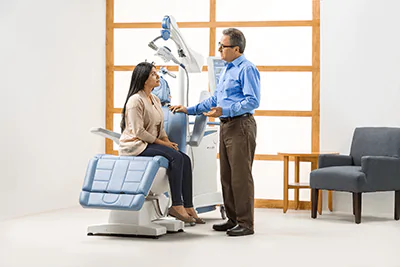Can Anxiety be Healthy?
So the question is; Can anxiety be healthy? Anxiety can happen to anyone; male, female, older, younger, teens, and children. While we use a photo above of a man, we did this just to avoid the stereotypical presentation of women struggling with anxiety.
Often, clients walk into therapy stating that their anxiety is through the roof and ruining their lives. Many clients report having panic attacks and stomach aches, others claim headaches and inflammation. In response, many begin to shut down—choosing to not engage in social activities due to their uncontrollable anxiety. Their anxiety is suffocating them.
Some clients even speak of their anxiety like it’s in charge and making decisions for them: “My anxiety makes me miss out on the fun things my friends are doing.” “I can’t go to concerts because of my anxiety.” “I can’t try out for baseball team. My anxiety will be unbearable.” They state that their quality of life is low because of their anxiety, and these are just the examples of fun activities; never mind those who cannot bear to even bring themselves to go to work or the store for fear of crowds and judgement, or those who engage in health-related rituals fueled by anxious thoughts.
Often, the ways that those suffering with anxiety attempt to manage it can be unhealthy and lead to a compounding of their discomfort and sense of hopelessness. For example, many turn to unhealthy substances, video games, food, and excessive sleep as ways to quiet their anxious feelings, thoughts and body sensations. They opt for external resources that offer immediate relief but no long-term solution.
Uncontrolled anxiety can affect an individual’s physical well-being–including, but not limited to–heart health, immune system function, blood pressure, increased cortisol (the stress hormone) levels, and can contribute to digestive tract issues as well. These coping strategies of choice can also contribute to long term health issues, including chronic respiratory disorders.
So, how on earth can anxiety ever be “healthy” if it has such unbridled capacity to wreak havoc on our lives and bodies?
The answer is that emotions including anxiety exist to give us information about what is going on with ourselves. When we are able to respond to anxiety in a healthy way, we are offered the opportunity to gain insight into ourselves and deepen our awareness of and connection to our bodies. Those who learn to manage their anxiety properly, use it to their advantage: they maintain productivity and motivation throughout their day. They make their anxiety work for them, rather than the other way around.
The Google definition of anxiety is “a feeling of worry, nervousness, or unease, typically about an imminent event or something with an uncertain outcome.” Anxiety at this level can be healthy or unhealthy, depending on one’s reaction. Emotions like this can serve as a signal to an individual that “something’s up.” It operates similar to a warning flag thrown up by our brain, indicating to the nervous system to send out an alert that says, “Pay attention! There is something important happening here.”
Perhaps the source of the anxiety is a test that hasn’t been studied for enough, or a looming deadline. Or maybe there’s a legitimate situation that poses a plausible threat to safety. This might look like someone entering a situation that is reminiscent of a particular traumatic incident that happened in the past. Anxiety of this sort is a signal to take some kind of action.
While most individuals will experience anxiety to some extent in their lives, anxiety becomes a clinical issue when it grows beyond what is tolerable and manageable for an individual. Some estimates state that nearly 30 percent of adults will experience an anxiety disorder at some point in their lives.
So how do we respond to anxiety in a more healthy way?
Daniel Siegel, MD developed the concept of a window of tolerance that represents the middle of the spectrum that looks at one’s ability to effectively cope with events and stressors that life throws their way. It represents the intersection between healthy brain, body and mind function and coordination. When a person is operating within their window of tolerance, they remain alert and able to identify their feelings, their thoughts and their body’s responses. Here, they are also able to respond to and effectively process stimuli.
Signs that someone is functioning within their window of tolerance include the ability to:
- Feel and think simultaneously
- Experience empathy
- Tolerate emotions
- Stay aware of the present moment
- Remain open and curious about their experience
- Maintain awareness of boundaries
- React appropriately to fit the situation
- Feel safe
The size of everyone’s window of tolerance varies. However, ideally, the window of tolerance should be broad—like a window flung open on a sunny, breezy day. Stress and trauma experienced over time can narrow the window of tolerance—like a semi-closed window on a windy, rainy day. A therapist who specializes in trauma can help reduce your trauma response.
Unhealthy responses can occur when people begin to become dysregulated and move into a hyper- or hypo-aroused state. Hyperarousal is the place “above” the window of tolerance where there is too much arousal and the nervous system moves into “fight and flight” types of responses. Signs that anxiety is escalating into hyper-arousal include:
- Tension or shaking
- Emotional reactivity
- Defensiveness
- Intrusive imagery
- Emotional overwhelm
- Feeling unsafe
- Obsessive/cyclical thoughts
- Hypervigilance
- Impulsivity
- Anger/rage
On the other hand, Hypo-arousal is the place “below” the window of tolerance where people tend to “numb-out” and become immobilized—almost frozen. Physical signs that a person is in hypo-arousal include:
- Relative absence of sensation
- No energy
- Reduced physical movement
- Seeming like they are “Not there” or spaced out
- Can’t defend oneself
- Can’t think
- Numbed emotions
- Disconnected
- Cut off from feelings
- Ashamed
- Lack of facial expression
- Shut down
- Passive
- Can’t say “no”.
Many unhealthy coping mechanisms related to the management of anxiety push people from being hyper-aroused by anxiety all the way down and PAST the window of tolerance and into the extreme of hypo-arousal. When people over-medicate with anti-anxiety medication or self-medicate by other means, they end up depressing their nervous systems so much that they often end up numbed out and unable to function optimally. They are only operating on the extremes of the spectrum, either way up or way down, and hardly in the middle, which is very unhealthy for the mind, brain and body.
So, to answer the question, “Can anxiety be healthy?”, the answer is “Yes it can.” The process of identifying and responding to emotions such as anxiety in new ways that help us grow and become more attuned with ourselves is healthy. Responding to anxiety successfully helps us to become more resilient individuals, and capable of navigating life’s challenges while remaining engaged and in touch with ourselves and the world around us.
Although anxiety can be healthy for some, it may take an experienced perspective to understand the role and function of anxiety in your life, and how it may be contributing to either health or dysfunction. Of course there is a fine line between using your anxiety for good, and allowing it permission to take over the driver’s seat of your life, and it is not always an easy task to accomplish.
Seeking honest input from a therapist or a trusted other might be the key to staying within your window of tolerance. At Nsight, our goal to help point you in the right direction, and to be with you every step along the way. Learn more about treatment for anxiety at Nsight if you or a loved one are struggling and need help.



